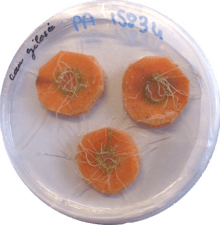Rhizobium rhizogenes
Rhizobium rhizogenes (formerly Agrobacterium rhizogenes) is a Gram-negative soil bacterium that produces hairy root disease in dicotyledonous plants. R. rhizogenes induces the formation of proliferative multiple-branched adventitious roots at the site of infection, so-called 'hairy roots'.[2]
| Rhizobium rhizogenes | |
|---|---|
 | |
| Scientific classification | |
| Kingdom: | |
| Phylum: | |
| Class: | |
| Order: | |
| Family: | |
| Genus: | |
| Species: | R. rhizogenes |
| Binomial name | |
| Rhizobium rhizogenes | |
| Synonyms | |
| |
In the rhizosphere, plants may suffer from wounds by soil pathogens or other sources. This leads to the secretion of phenolic compounds like acetosyringone which have chemotactic effects that attract the bacteria. Under such conditions, certain bacterial genes are turned on leading to the transfer of its T-DNA from its root-inducing plasmid (Ri plasmid) into the plant through the wound. After integration and expression, in vitro or under natural conditions, the hairy root phenotype is observed, which typically includes overdevelopment of a root system that is not completely geotropic, and altered (wrinkled) leaf morphology, if leaves are present.[3]
Bacterial genes may be retained within the plant.[4]
The hairy roots are grown in vitro in bioreactors to study their soil interaction with other pathogens like fungi and nematodes. This technique has also led to the commercial production of certain metabolic compounds that the plant is known to secrete, especially in regard to the medicinal plants that are difficult to cultivate in sufficient quantities by other means.[5] The root cultures are also used for genetic engineering.[6][7]
References
- Young JM, Kuykendall LD, Martínez-Romero E, Kerr A, Sawada H (2001). "A revision of Rhizobium Frank 1889, with an emended description of the genus, and the inclusion of all species of Agrobacterium Conn 1942 and Allorhizobium undicola de Lajudie et al. 1998 as new combinations: Rhizobium radiobacter, R. rhizogenes, R. rubi, R. undicola, and R. vitis". Int J Syst Evol Microbiol. 51: 89–103. doi:10.1099/00207713-51-1-89.
- Chilton MD, Tepfer D, Petit A, David C, Casse Delbart FT. Agrobacterium rhizogenes insert T-DNA into the genome of the host plant root cells. nature. 1982; 295:432-4
- Cardarelli M, Mariotti D, Pomponi M, Spanò L, Capone I, Costantino P. 1987. "Agrobacterium rhizogenes T-DNA genes capable of inducing hairy root phenotype". Molecular and General Genetics 209(3):475-480.
- Intrieri, M. C. & Buiatti, M. (July 2001). "The horizontal transfer of Agrobacterium rhizogenes genes and the evolution of the genus Nicotiana". Molecular Phylogenetics and Evolution. 20 (1): 100–110. doi:10.1006/mpev.2001.0927. PMID 11421651.
- Shanks JV, Morgan J (April 1999). "Plant 'hairy root' culture". Curr. Opin. Biotechnol. 10 (2): 151–5. doi:10.1016/S0958-1669(99)80026-3. PMID 10209145.
- Otani, M.; Mii, M.; Handa, T.; Kamada, H. & Shimada, T. (1993). "Transformation of sweet potato (Ipomoea batatas (L.) Lam.) plants by Agrobacterium rhizogenes". Plant Science. 94 (1–2): 151–159. doi:10.1016/0168-9452(93)90016-S.
- Van de Velde, W.; Mergeay, J.; Holsters, M. & Goormachtig, S. (December 2003). "Agrobacterium rhizogenes-mediated transformation of Sesbania rostrata". Plant Science. 165 (6): 1281–1288. doi:10.1016/S0168-9452(03)00339-X.